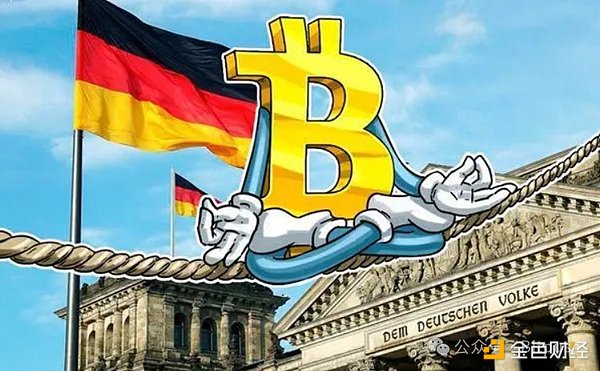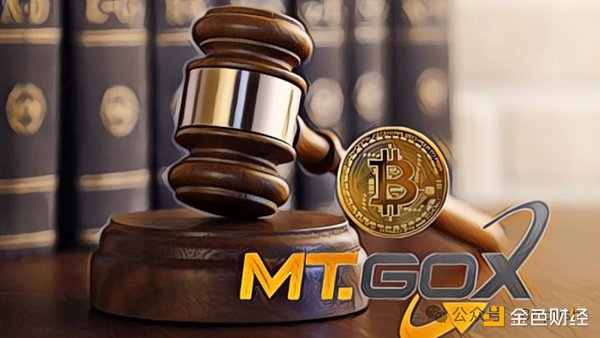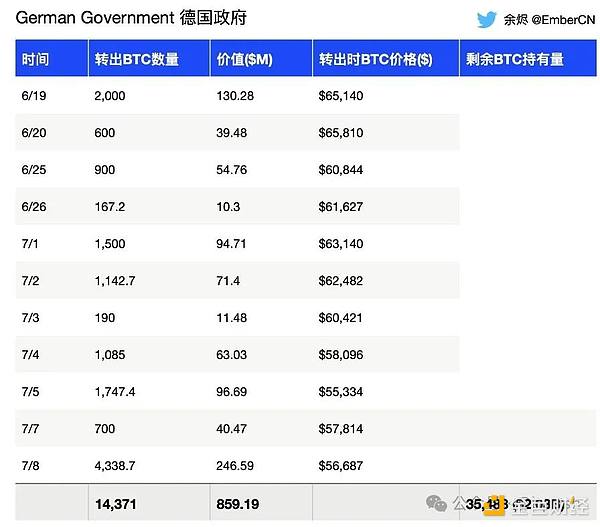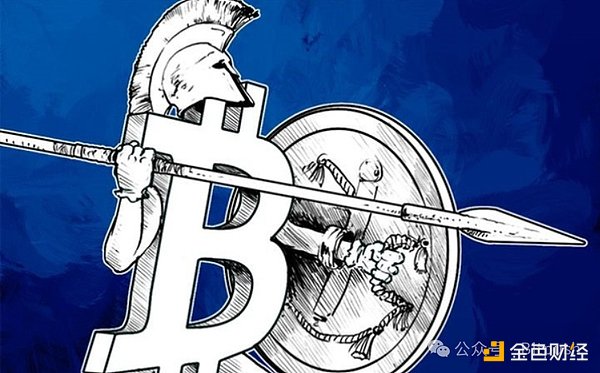Author: BitPush
The main reason for this round of decline is the German government's dumping and Mt.Gox's compensation. So, has the impact of Mt.Gox's compensation become smaller? Has the German government's selling pressure weakened? How will the Bitcoin market develop in the future?
Recently, after the sharp drop in Bitcoin, market sentiment has become optimistic again. So, is a reversal coming soon? The main reason for this round of decline is the German government's dumping and Mt.Gox's compensation. So, has the impact of Mt.Gox's compensation become smaller? Has the German government's selling pressure weakened? How will the Bitcoin market develop in the future?

Has the impact of Mt.Gox's compensation become smaller? Will Bitcoin rebound or reverse in the short term?
With the continuous decline of Bitcoin, the market is eager for some psychological massage and comfort, which is normal. From the perspective of technical analysis, Bitcoin has deviated significantly from multiple moving averages (MA), and a certain rebound is also caused by the market, but it is unlikely to directly reverse in a V shape in the short term. Recently, the remarks of many analysts may be invalid in the face of facts.
Has the impact of Mt.Gox's compensation really become smaller? A crypto analyst at Bitbank, a cryptocurrency exchange that supports the Mt.Gox compensation work, said: "It is expected that the change in Mt.Gox's wallet balance will have a smaller impact on the market. When the Mt.Gox trustee officially announced that they had begun to repay, Bitcoin had already fluctuated around $54,000. After the news was announced, the price of Bitcoin rebounded and briefly rebounded to $58,000 last weekend." This article believes that it is not that the impact of Mt.Gox has become smaller, but that the market anticipated it before Mt.Gox's compensation. When the actual compensation began, Bitcoin had already fallen sharply. At this time, Bitcoin holders who received compensation will not rush to sell. However, after Bitcoin begins to rebound to a certain extent, users who have received compensation from Mt.Gox may begin to truly stress test Bitcoin.
So, when will the real selling pressure of Mt.Gox come? The bankruptcy liquidator has previously detailed that the timeline for compensation to be visible in creditors' accounts may vary from exchange to exchange: Kraken may take up to 90 days; Bitstamp may take 60 days; BitGo is 20 days; SBI VC Trade and Bitbank will complete compensation within 14 days. If this cycle is followed, most creditors may be compensated in the next two months. However, according to BitPush, two of the Japanese exchanges (Bitbank and SBI VC Trade) have received and seemingly distributed the received distribution funds, completing the distribution in just a few hours, rather than the maximum two weeks initially agreed. In addition, Bitstamp said in a statement: "According to the agreement with the Mt.Gox trustee, Bitstamp has 60 days to distribute tokens, but we will work hard to ensure that these investors are compensated as soon as possible." This may mean that the real selling pressure from Mt.Gox creditors should be after the next month.

Has the German government's selling pressure eased? Should we be optimistic at this moment?
There is no doubt that in addition to the compensation from Mt.Gox, the real selling pressure is from the German government. The German government seems to expect Bitcoin to fall sharply, and has recently sold its Bitcoin frequently. It may want to clear its Bitcoin holdings as much as possible before retail investors get compensation from Mt.Gox, so as to escape in advance. However, the market seems to be too optimistic about the German government's selling pressure. Let's take a look at the more eye-catching analysis in the market.
Through sorting, this article believes that the bullish sentiment in the market mainly comes from the following key indicators: 1. The market pullback is mainly due to concerns about market sell-offs due to Mt.Gox's continued repayment of more than 140,000 BTC to its customers and the German government's BTC liquidation. Although prices continue to fall, selling pressure is weakening. In technical analysis, this situation usually indicates that the current downward trend may reverse or slow down; 2. Two classic technical indicators support the bullish reversal scenario, the hammer line is bullish, and the oversold RSI. Bitcoin BTC formed a bullish hammer line pattern on July 5. In addition, the daily RSI reading hovered around the oversold threshold of 30, which usually indicates a consolidation or recovery period; 3. Wall Street is betting on an increased probability of a rate cut in September. According to CME data, as of July 7, Wall Street traders believed that the probability of a 25 basis point rate cut by the Federal Reserve was 72%. A month ago, the probability was 46.60%; 4. Bitcoin ETF investors returned after the July decline, and after two consecutive days of capital outflows, the capital inflow of US spot Bitcoin ETFs resumed; 5. The US money supply expanded again; 6. Bitcoin miners surrendered, suggesting that the BTC price has bottomed out.
First, is the German government's sell-off over? On July 8, on-chain analyst Yu Jin said that the German government had transferred 4,338.7 BTC ($246.59M) to exchanges and market makers today (June 8), which was the day with the most BTC transferred since they started selling coins on June 19.

On the evening of July 9, according to Arkham monitoring, in the past 3 hours, the German government has transferred 6306.9 BTC (US$362.12 million) to Kraken, Cumberland, 139Po (possibly institutional deposits/OTC services) and address bc1qu. Among them, 3206.9 BTC (US$184.58 million) were transferred out in the past 20 minutes. Since yesterday, the German government has received 5366 BTC from exchanges including Kraken, Bitstamp and Coinbase.
Overall, the German government is selling like crazy, and the market's short-term bullish sentiment has been almost directly suppressed. At present, the German government still holds 22,847 BTC (US$1.32 billion). At this pace, it is expected that the market will hardly reverse directly in the short term. In addition, as mentioned above in this article, most of Mt.Gox's compensation work may not be completed until late July, when Bitcoin may face continued selling pressure.
Crypto analyst Alex Krüger published an article on the X platform to analyze and calculate the decline that can be caused by Mt.Gox compensation and the German government address selling Bitcoin. According to the current market liquidity and the market decline caused by several previous large-scale transfers of Bitcoin, Krüger made a pessimistic assumption, that is, if the German government address sells the remaining Bitcoin at one time and 30% of the 85,000 Bitcoins held by Mt.Gox are sold, then the selling of Mt.Gox and the German government may cause the price of Bitcoin to fall rapidly by 10.5%, but in general, the market can fully absorb the above selling pressure.

Although it is necessary to be cautious at present, it is still worth looking forward to in late July
The author remains vigilant about the current optimism, but is still relatively optimistic about the market in late July. Although shorts still have an advantage in mid-July, the market is like this, and the long and short positions are quietly changing without being noticed; and the forces driving the change in the crypto market include the rising expectations of the Fed's interest rate cut, the approval of the Ethereum ETF, the US election, and the OP_CAT technology upgrade.
The author has repeatedly mentioned the factors that may drive the development of Bitcoin in the articles "How much will the Mt.Gox compensation hit BTC? Can the crypto market still stage a five-year poverty, six-year poverty, and seven-year turnaround?" on June 28 and "The July script has been written, how will Bitcoin fight a turnaround?" on July 3. From the current perspective, with the rising expectations of the Fed's interest rate cut, the US stock market has performed well recently, but the crypto market has performed poorly. This is mainly due to the selling and smashing of Mt.Gox creditors and the German government, which is the main reason for the short-term impact on the market. However, the improvement of the macro environment is real, which will prompt institutional funds to buy high and sell low and pay attention to crypto assets such as Bitcoin. In addition, according to the latest news, the Ethereum ETF may be approved on July 15. Once the Ethereum ETF is approved, it will inject new funds into the crypto market, and an institutional bottom-fishing drama will probably be staged, which will also completely trigger the market to reverse. Even if the Ethereum ETF cannot be approved on July 15, it may not be a bad thing. In a sense, if it is approved at the end of July or early August, it will be more conducive to the trend reversal of the crypto market.
In addition, on June 25, the technology media Axios quoted two people familiar with the matter as saying that former US President Trump is discussing giving a speech at the Bitcoin 2024 conference in Nashville at the end of July. The Bitcoin 2024 conference will be hosted by Bitcoin Magazine and is scheduled to be held from July 25 to 27. If Trump participates in the Bitcoin conference in order to gain the support of crypto people, this will most likely directly trigger a surge in Bitcoin.
Summary
From the perspective of the German government and the selling pressure of Mt.Gox creditors, this article believes that the current crypto market is still tending to rebound rather than reverse. However, by late July, most of the compensation work for Mt.Gox creditors may be completed. Under the influence of many factors such as the rising expectations of the Federal Reserve's interest rate cuts, the approval of the Ethereum ETF, the US election, and the OP_CAT technology upgrade, a new round of Bitcoin's rise may begin.
 JinseFinance
JinseFinance
 JinseFinance
JinseFinance Joy
Joy Catherine
Catherine Beincrypto
Beincrypto Beincrypto
Beincrypto Bitcoinist
Bitcoinist Nulltx
Nulltx Nulltx
Nulltx Nulltx
Nulltx Nulltx
Nulltx